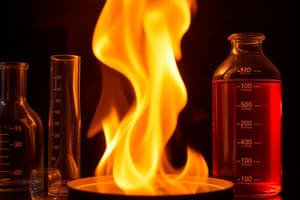Podcast
Questions and Answers
Which statement supports how a change in conditions can increase the rate of the reaction C12H22O11(aq) + H2O(l) → 2C6H12O6(aq)?
Which statement supports how a change in conditions can increase the rate of the reaction C12H22O11(aq) + H2O(l) → 2C6H12O6(aq)?
Increasing the concentration of sucrose will increase the rate of hydrolysis by increasing the frequency of the collisions between the sucrose and the water molecules.
Which statement explains why the initial rate of formation of N2 is greater in trial 2 than in trial 1 for the reaction 2NO(g) + 2H2(g) → N2(g) + 2H2O(g)?
Which statement explains why the initial rate of formation of N2 is greater in trial 2 than in trial 1 for the reaction 2NO(g) + 2H2(g) → N2(g) + 2H2O(g)?
The frequency of collisions between reactant molecules is greater in trial 2 than it is in trial 1.
Which trial will have a faster initial rate of reaction involving Zn(s) and why?
Which trial will have a faster initial rate of reaction involving Zn(s) and why?
Trial 2, because the sample of Zn(s) has a greater surface area for the reaction to take place.
Based on the rate expression rate = k[CH3I][NaOH], what happens if the concentration of CH3I is doubled?
Based on the rate expression rate = k[CH3I][NaOH], what happens if the concentration of CH3I is doubled?
For the reaction 2N2O5(g) → 4NO2(g) + O2(g), what is the order of the reaction?
For the reaction 2N2O5(g) → 4NO2(g) + O2(g), what is the order of the reaction?
Which quantity plotted versus time will produce a straight line for the decay of Bismuth-214 to Polonium-214?
Which quantity plotted versus time will produce a straight line for the decay of Bismuth-214 to Polonium-214?
What is the best representation of the rate law for the catalyzed decomposition of NH3(g)?
What is the best representation of the rate law for the catalyzed decomposition of NH3(g)?
What is the overall reaction for the provided mechanism involving H2O2 and I−?
What is the overall reaction for the provided mechanism involving H2O2 and I−?
Based on the proposed reaction mechanism for N2O5 decomposition, what is the correct identification of the chemical equation and rate law?
Based on the proposed reaction mechanism for N2O5 decomposition, what is the correct identification of the chemical equation and rate law?
For the proposed mechanism of H2 and IBr, what happens if the initial concentrations of both reactants are doubled?
For the proposed mechanism of H2 and IBr, what happens if the initial concentrations of both reactants are doubled?
What is the rate law for the elementary reaction involving 2NO + O2 → 2NO2?
What is the rate law for the elementary reaction involving 2NO + O2 → 2NO2?
What is the rate law expression for the reaction H2 + I2 → 2HI based on a two-step mechanism?
What is the rate law expression for the reaction H2 + I2 → 2HI based on a two-step mechanism?
Identify the catalyst in the mechanism of HCOOH decomposition and justify the choice.
Identify the catalyst in the mechanism of HCOOH decomposition and justify the choice.
Which reaction energy profile corresponds to a catalyzed reaction?
Which reaction energy profile corresponds to a catalyzed reaction?
What is the experimental rate law for the reaction 2X + Y2 → X2Y2?
What is the experimental rate law for the reaction 2X + Y2 → X2Y2?
Based on initial rates of disappearance of X in the reaction 2X + Y2 → X2Y2, what is the result for experiment 1?
Based on initial rates of disappearance of X in the reaction 2X + Y2 → X2Y2, what is the result for experiment 1?
What conclusion can be drawn about the second chemist's measurements compared to the first?
What conclusion can be drawn about the second chemist's measurements compared to the first?
Flashcards are hidden until you start studying
Study Notes
Reaction Rates and Mechanisms
- Hydrolysis of sucrose is accelerated by increasing its concentration, enhancing collision frequency with water.
- In a reaction involving nitrogen oxides, a higher rate of N2 formation in one trial indicates increased collision frequency of reactants.
Catalysts and Reaction Efficiency
- A greater surface area of zinc enhances reaction rates due to more available collision sites.
- The reaction rate of CH3I and NaOH will double if CH3I concentration is increased while NaOH remains constant.
- Sulfuric acid acts as a catalyst in formic acid decomposition, as it is regenerated after being consumed in the initial step.
Elementary Steps and Rate Laws
- First-order reactions have a specific concentration-dependence, characterized by corresponding ln[Reactant] plots.
- Rate laws derived from elementary steps reflect the slowest step's impact on overall reaction kinetics.
- In a multi-step reaction, the slower step dictates rate laws, which vary based on reactant concentration.
Energy Profiles and Effective Collisions
- Effective collisions require proper orientation and sufficient energy to overcome activation barriers.
- Reaction energy profiles demonstrate that catalyzed reactions lower activation energy compared to uncatalyzed pathways.
Experimental Observations and Rate Laws
- Student experiments yield varying initial rates, suggesting that different conditions (like catalysts) influence the observed rates.
- Rate laws are empirically determined from initial rates measured at varying reactant concentrations.
- A higher temperature results in more molecules able to overcome activation energy, accelerating the reaction.
Proposed Mechanisms and Intermediates
- Proposed mechanisms consist of elementary steps, some of which may return reactants to the reaction pathway.
- Reaction intermediates are formed during a mechanism and are not seen in the overall balanced equation.
Studying That Suits You
Use AI to generate personalized quizzes and flashcards to suit your learning preferences.




